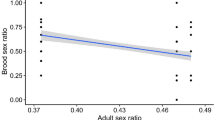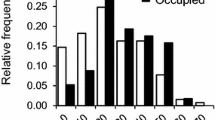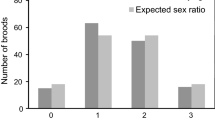Summary
Red-winged Blackbird (Agelaius phoeniceus) offspring sex ratios at hatch were determined for 97 clutches suffering no egg loss or infertility and produced an overall sex ratio of 1 male: 0.94 females.
Offspring sex ratios varied seasonally, with early and late initiating females producing more female offspring and mid-season initiators producing more males. While this pattern is in keeping with the assumed pattern of seasonal resource abundance, the sex ratio biases seen were at best only slight.
Using two measures of male quality, no support was found for the hypothesis that females should preferentially produce sons when mated to high quality males. The data did suggest, however, that females may reduce the variance in offspring sex ratios in larger harems. Some alternative interpretations are presented.
Similar content being viewed by others
References
Bray OE, Kennelly JJ, Guarino JL (1975) Fertility of eggs produced on territories of vasectomized Red-winged Blackbirds. Wilson Bull 87:187–195
Burley N (1981) Sex ratio manipulation and selection for attractiveness. Science 211:721–722
Clutton-Brock TH (1982) Sons and daughters. Nature 298:11–12
Fiala KL (1981) Sex ratio constancy in the Red-winged Blackbird. Evolution 35:898–910
Holm CH (1973) Breeding sex ratios, territoriality, and reproductive success in the Red-winged Blackbird (Agelaius phoeniceus). Ecology 49:682–694
Howe HF (1977) Sex-ratio adjustment in the Common Grackle. Science 98:744–746
Immelmann K, Hailman JP, Baylis JB (1982) Reputed band attractiveness and sex manipulation in Zebra Finches. Science 215:422
Patterson CB, Emlen JM (1980) Variation in nestling sex ratios in the Yellow-headed Blackbird. Am Nat 115:743–747
Thissen D, Martin E (1982) Reputed band attractiveness and sex manipulation in Zebra Finches. Science 215:423
Trivers RL, Willard DE (1973) Natural selection of parental ability to vary the sex ratio of offspring. Science 179:90–92
Weatherhead PJ, Robertson RJ (1977a) Male behavior and female recruitment in the Red-winged Blackbird. Wilson Bull 89:583–592
Weatherhead PJ, Robertson RJ (1977b) Harem size, territory quality, and reproductive success in the Red-winged Blackbird. Can J Zool 55:1261–1267
Weatherhead PJ, Robertson RJ (1981) In defence of the sexy son hypothesis. Am Nat 117:349–356
Williams GC (1979) The question of adaptive sex ratio in outcrossed vertebrates. Proc R Soc Lond [Biol] 205:567–580
Author information
Authors and Affiliations
Rights and permissions
About this article
Cite this article
Weatherhead, P.J. Secondary sex ratio adjustment in red-winged Blackbirds (Agelaius phoeniceus). Behav Ecol Sociobiol 12, 57–61 (1983). https://doi.org/10.1007/BF00296933
Received:
Accepted:
Issue Date:
DOI: https://doi.org/10.1007/BF00296933




